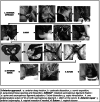Anterior bilateral sacrospinous ligament fixation with concomitant anterior native tissue repair: a pilot study
- PMID: 35226145
- PMCID: PMC8883458
- DOI: 10.1007/s00192-022-05092-x
Anterior bilateral sacrospinous ligament fixation with concomitant anterior native tissue repair: a pilot study
Abstract
Introduction and hypothesis: Anterior bilateral sacrospinous ligament fixation (ABSSLF) was first described in 2000 but only evaluated in a limited number of studies. However, due to the FDA's ban on transvaginal mesh, interest in this technique has re-emerged. The SSLF procedure is known for its inherent high risk for anterior compartment failure; hence, in our center we started performing a preemptive concomitant anterior repair with the intention to reduce such risk. The aim of this study was to review the feasibility and clinical outcomes of this innovative technique.
Methods: We performed a retrospective cohort study of all the women who had an ABSSLF and a concomitant anterior native tissue repair between May 2019 and July 2020 in a tertiary hospital in France. Our primary endpoint was surgical feasibility, while as secondary endpoints we wanted to explore the perioperative morbidities and clinical outcomes associated with this technique.
Results: A total of 50 women were operated on in the studied period. The median follow-up time was 10 [8.5] months. It was feasible to perform the combined ABSSLF and concomitant anterior native tissue repair in all cases. The most frequent perioperative complications reported were urinary tract infection (14%) and difficulty in resuming voiding (16%). Anatomical and functional results were improved. The rate of anterior compartment recurrence was 37%.
Conclusions: ABSSLF with a concomitant anterior native tissue repair is feasible and relatively safe for treating anterior and apical pelvic prolapse. However, anterior compartment failure rate is still a limitation. Further larger studies with long-term anatomical and functional results comparing this technique to alternative transvaginal surgical approaches are needed.
Keywords: Anterior approach; Bilateral sacrospinous ligament fixation (BSSLF); Native tissue repair; Pelvic organ prolapse; Uterosacral ligament suspension; Vaginal prolapse repair.
© 2022. The International Urogynecological Association.
Conflict of interest statement
Prof. De Tayrac and Dr. Fatton are consultants for Boston Scientific; remaining authors claim no conflict of interest.
Similar articles
-
[A five-year analysis of effect on transvaginal high uterosacral ligament suspension with or without native-tissue repair for middle compartment defect].Zhonghua Fu Chan Ke Za Zhi. 2019 Jul 25;54(7):445-451. doi: 10.3760/cma.j.issn.0529-567x.2019.07.003. Zhonghua Fu Chan Ke Za Zhi. 2019. PMID: 31365956 Chinese.
-
[Effectiveness of vaginal high uterosacral ligament suspension for treatment of recurrent pelvic organ prolapse].Zhonghua Fu Chan Ke Za Zhi. 2019 Apr 25;54(4):232-238. doi: 10.3760/cma.j.issn.0529-567x.2019.04.004. Zhonghua Fu Chan Ke Za Zhi. 2019. PMID: 31006188 Chinese.
-
Long-term reoperation risk after apical prolapse repair in female pelvic reconstructive surgery.Am J Obstet Gynecol. 2022 Aug;227(2):306.e1-306.e16. doi: 10.1016/j.ajog.2022.05.046. Epub 2022 May 30. Am J Obstet Gynecol. 2022. PMID: 35654112
-
Native Tissue Prolapse Repairs: Comparative Effectiveness Trials.Obstet Gynecol Clin North Am. 2016 Mar;43(1):69-81. doi: 10.1016/j.ogc.2015.10.003. Obstet Gynecol Clin North Am. 2016. PMID: 26880509 Review.
-
Prolapse Repair Using Non-synthetic Material: What is the Current Standard?Curr Urol Rep. 2019 Oct 14;20(11):70. doi: 10.1007/s11934-019-0939-8. Curr Urol Rep. 2019. PMID: 31612341 Review.
Cited by
-
Anterior and Apical Prolapse: Comparison of Vaginal Mesh Surgery to Vaginal Surgery with No Mesh.J Clin Med. 2023 Mar 13;12(6):2212. doi: 10.3390/jcm12062212. J Clin Med. 2023. PMID: 36983214 Free PMC article.
-
Anatomical and functional outcomes after bilateral sacrospinous colposuspension (BSC) for the treatment of female genital prolapse.BMC Urol. 2023 Mar 29;23(1):48. doi: 10.1186/s12894-023-01213-w. BMC Urol. 2023. PMID: 36991400 Free PMC article.
-
Evaluation of the clinical effectiveness of modified sacrospinous ligament fixation via the anterior vaginal wall path for pelvic organ prolapse: A feasibility report based on 50 patients.Front Surg. 2022 Nov 2;9:1010027. doi: 10.3389/fsurg.2022.1010027. eCollection 2022. Front Surg. 2022. PMID: 36406350 Free PMC article.
-
Comparison of Early Postoperative Outcomes for Vaginal Anterior Sacrospinous Ligament Fixation with or without Transvaginal Mesh Insertion.J Clin Med. 2023 May 25;12(11):3667. doi: 10.3390/jcm12113667. J Clin Med. 2023. PMID: 37297862 Free PMC article.
-
Mobility analysis of a posterior sacrospinous fixation using a finite element model of the pelvic system.PLoS One. 2024 Mar 21;19(3):e0299012. doi: 10.1371/journal.pone.0299012. eCollection 2024. PLoS One. 2024. PMID: 38512958 Free PMC article. Clinical Trial.
References
-
- FDA Public Health Notification (Medical Devices): Urogynecologic Surgical Mesh Implants. 2019. http://www.fda.gov/medical-devices/implants-and-prosthetics/urogynecolog.... Accessed 17 June 2019.
-
- Ouzaid I, Ben Rhouma S, de Tayrac R, Costa P, Prudhomme M, Delmas V. Sacrospinofixation mini-invasive avec le dispositif CAPIO : étude anatomique [Mini-invasive posterior sacrospinous ligament fixation using the CAPIO needle driver: an anatomical study]. Prog Urol. 2010;20(7):515–9. French. - PubMed
Publication types
MeSH terms
LinkOut - more resources
Full Text Sources
Medical


